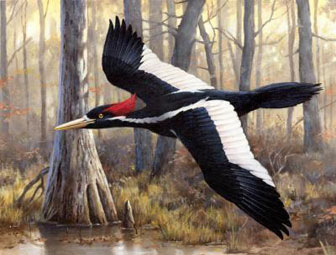Robots aid in search for Ivory-billed woodpecker
Robots aid in search for Ivory-billed woodpecker
mongabay.com
February 17, 2007
Scientists have installed robotic cameras to help in the search of the world’s most elusive bird, the Ivory-billed woodpecker.
The high-resolution intelligent robotic video system was developed by researchers from the University of California at Berkeley and Texas A&M University and put into place in the Bayou DeView area of the Cache River National Wildlife Refuge in Arkansas, historic habitat for the bird which some ornithologists claim to have sighted over the past 3 years despite its apparent extinction 1944 due to widespread destruction of its hardwood swamps and pine forest habitat in the southern United States. These claims have been met with heated debate in the birding community with some arguing that the biologists are mistaking a closely related species with the Ivory-billed.
“There is no credible evidence that the North American subspecies of Ivory-billed Woodpecker Campephilus principalis survived after the demise of the Singer Tract birds in the 1940s after the last substantial patch of old-growth habitat was destroyed,” stated WorldTwitch.com, a birding web site run by John Wall. “What can only be another routine case of misidentification of the common Pileated Woodpecker Dryocopus pileatus in good Pileated but poor Ivorybill habitat in Arkansas has been promoted as the latest Ivorybill ‘rediscovery’.”
The researchers hope the new system can put the debate to rest.
|
|
“A single photographic frame would have to clearly show the unique markings of the ivory-billed woodpecker,” said Ken Goldberg, a UC Berkeley professor of industrial engineering and operations research, speaking at the annual meeting of the American Association for the Advancement of Science (AAAS) in San Francisco. “Much better would be a high-resolution video clip that would also capture its unique wing and flight patterns.”
A pair of cameras – one pointing east and the other west – have been placed on a power line that cuts through the bayou and provides a 50-foot-wide clearing unobstructed by trees.
“It’s a natural bottleneck in the forest, and birds passing through that corridor are relatively easy to spot because they expose themselves,” said Ron Rohrbaugh, project director at the Cornell Lab of Ornithology. “At this location, we should have the highest probability of capturing an image of the ivory-billed woodpecker.”
The cameras are connected to a computer that processes the data. The researchers created software that retains video only when potential “bird flight” movement is sensed. Potential “bird flight” movement has been defined using a complex algorithm.
“The program knows, for instance, that the ivory-billed woodpecker flies 20 to 40 miles per hour, so anything outside that range is deleted,” said Dezhen Song, an assistant professor of computer science at Texas A&M, who worked with Ni Qin, a computer science Ph.D. student at Texas A&M, on the software.
The researchers will continue to fine tune the system and algorithms as they examine the video data.
“I’m a person who’s been in the outdoors all my life, and I’m trained as a wildlife biologist,” said Rohrbaugh. “Certainly going into this I had a lot of skepticism about the usefulness of this robotic camera. But now there’s hope that by using this camera, we can get a hi-res image that is an indisputable piece of evidence that the ivory-billed woodpecker is living in Arkansas.”
“I’m hopeful, but not overconfident,” Goldberg said. “We’re willing to run this camera for years, and we’re prepared to accept it if we never see the bird. But if this persistent robot out on the bayou manages to capture verifiable high-resolution images of the legendary ivory-bill, it would be a major discovery for scientists, for conservationists and for more than 45 million American bird-watchers.”
This article is based on a news releases from UC Berkeley and Texas A&M.
